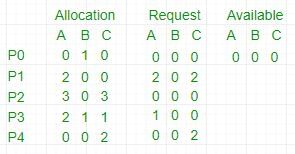Computer Science Engineering (CSE) Exam > Computer Science Engineering (CSE) Notes > Operating System > Deadlock Detection Algorithm
Deadlock Detection Algorithm | Operating System - Computer Science Engineering (CSE) PDF Download
Introduction
If a system does not employ either a deadlock prevention or deadlock avoidance algorithm then a deadlock situation may occur. In this case:
- Apply an algorithm to examine state of system to determine whether deadlock has occurred or not.
- Apply an algorithm to recover from the deadlock. For more refer- Deadlock Recovery
Deadlock Avoidance Algorithm/ Bankers Algorithm
The algorithm employs several times varying data structures:
- Available:
A vector of length m indicates the number of available resources of each type. - Allocation:
An n*m matrix defines the number of resources of each type currently allocated to a process. Column represents resource and resource represent process. - Request:
An n*m matrix indicates the current request of each process. If request[i][j] equals k then process Pi is requesting k more instances of resource type Rj.
Now, Bankers algorithm includes a Safety Algorithm / Deadlock Detection Algorithm
The algorithm for finding out whether a system is in a safe state can be described as follows:
Steps of Algorithm:
- Let Work and Finish be vectors of length m and n respectively. Initialize Work= Available. For i=0, 1, …., n-1, if Requesti = 0, then Finish[i] = true; otherwise, Finish[i]= false.
- Find an index i such that both
a) Finish[i] == false
b) Requesti <= Work
If no such i exists go to step 4.
Work= Work+ Allocationi
Finish[i]= true
Go to Step 2. - If Finish[i]== false for some i, 0<=i<n, then the system is in a deadlocked state. Moreover, if Finish[i]==false the process Pi is deadlocked.
For example,

- In this, Work = [0, 0, 0] &
Finish = [false, false, false, false, false] - i = 0 is selected as both Finish[0] = false and [0, 0, 0] <= [0, 0, 0].
- Work =[0, 0, 0] + [0, 1, 0] => [0, 1, 0] &
Finish = [true, false, false, false, false]. - i = 2 is selected as both Finish[2] = false and [0, 0, 0] <= [0, 1, 0].
- Work = [0, 1, 0] + [3, 0, 3] => [3, 1, 3] &
Finish = [true, false, true, false, false]. - i = 1 is selected as both Finish[1] = false and [2, 0, 2] <= [3, 1, 3].
- Work = [3, 1, 3] + [2, 0, 0] => [5, 1, 3] &
Finish = [true, true, true, false, false]. - i = 3 is selected as both Finish[3] = false and [1, 0, 0] <= [5, 1, 3].
- Work =[5, 1, 3] + [2, 1, 1] => [7, 2, 4] &
Finish = [true, true, true, true, false]. - i = 4 is selected as both Finish[4] = false and [0, 0, 2] <= [7, 2, 4].
- Work = [7, 2, 4] + [0, 0, 2] => [7, 2, 6] &
Finish = [true, true, true, true, true].
Since Finish is a vector of all true it means there is no deadlock in this example.
The document Deadlock Detection Algorithm | Operating System - Computer Science Engineering (CSE) is a part of the Computer Science Engineering (CSE) Course Operating System.
All you need of Computer Science Engineering (CSE) at this link: Computer Science Engineering (CSE)
|
10 videos|141 docs|33 tests
|
Related Searches
















